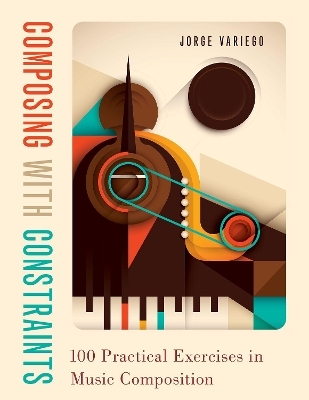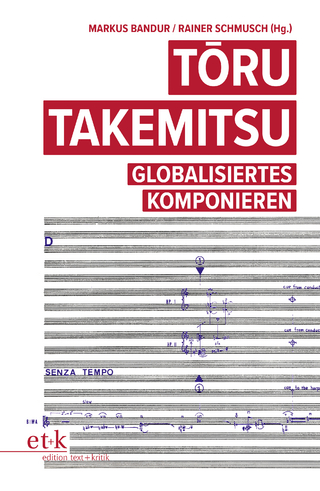
Composing with Constraints
Oxford University Press Inc (Verlag)
978-0-19-005724-4 (ISBN)
Each chapter starts with a brief note on terminology and general recommendations for the instructor. The first five chapters offer a variety of exercises that range from analysis and style imitation to the use of probabilities. The chapter about pre-compositional approaches offers original techniques that a student composer can implement in order to start a new work. Based on lateral thinking, the last section of the book fosters creative connections with other disciplines such as math, visual arts, and architectural acoustics.
The one hundred exercises contain a unique set of guidelines and constraints that place students in a specific compositional framework. These compositional boundaries encourage students to produce creative work within a given structure. Using the methodologies in this book, students will be able to create their own outlines for their compositions, making intelligent and educated compositional choices that balance reasoning with intuition.
Jorge Variego was born in Rosario, Argentina. He is a former Fulbright Scholar and is currently Lecturer in Music Theory at the University of Tennessee - Knoxville, where is also the Founding Director of the UT Electroacoustic Ensemble.
Introduction
How to use the book
Recommendations for the instructor
Chapter I - Melody (exercises 1 - 20)
Preliminary notes
Melody 1 - focal point
Melody 2 - using your own scale
Melody 3 - using your own scale and a subset
Melody 4 - using your own scale with a substitute pitch
Melody 5 - a scale in a given order
Melody 6 - a scale in a given order with ordered rhythm
Melody 7 - concatenating triads
Melody 8 - concatenating triads of any type
Melody 9 - segments of equal duration
Melody 10 - segments of unequal duration
Melody 11 - the melody of an image
Melody 12 - integer notation
Melody 13 - integer notation collections and subsets
Melody 14 - integer notation collections and transition subsets
Melody 15 - simple probabilities
Melody 16 - a twelve-tone row
Melody 17 - a twelve-tone row in palindrome
Melody 18 - intervallic content
Melody 19 - leitmotifs
Melody 20 - eliminations
Chapter II - Harmony (exercises 21 - 40)
Preliminary notes
Harmony 21 - composing transitions
Harmony 22 - using segments, melody becomes harmony
Harmony 23 - axis of symmetry Harmony 24 - using the harmonic series
Harmony 25 - using the harmonic series with a pedal tone
Harmony 26 - just triads
Harmony 27 - using integer notation
Harmony 28 - diatonic?
Harmony 29 - a twelve-tone row
Harmony 30 - alla circle progression
Harmony 31 - triads that move in thirds
Harmony 32 - triads that move in thirds and progressions within a progression
Harmony 33 - polychords, triads over triads
Harmony 34 - polytonality
Harmony 35 - pedal tones
Harmony 36 - ideas using parallel modes
Harmony 37 - clusters
Harmony 38 - sequences and patterns
Harmony 39 - implied harmonies
Harmony 40 - contrafacts
Chapter III - Rhythm (exercises 41 - 60)
Preliminary notes
Rhythm 41 - transformations using simple math
Rhythm 42 - using segments
Rhythm 43 - using segments per measure
Rhythm 44 - non-retrogradable rhythms
Rhythm 45 - patterns within patterns
Rhythm 46 - extracting the rhythm of a text
Rhythm 47 - why meter?
Rhythm 48 - short, long, long, short - using Morse code
Rhythm 49 - ostinato
Rhythm 50 - playing with hemiolas
Rhythm 51 - hemiolas and melodic construction
Rhythm 52 - polymeter
Rhythm 53 - metric modulations
Rhythm 54 - using rhythmic motifs
Rhythm 55 - motivic displacement
Rhythm 56 - isorhythmic motets, talea and color
Rhythm 57 - repeat signs, loops and internal spiraling
Rhythm 58 - composing with unequal rests and pauses
Rhythm 59 - eliminations, everything coming from the same tune
Rhythm 60 - perceivable and non-perceivable pulse
Chapter IV - Texture (exercises 61 - 80)
Preliminary notes
Texture 61 - analyzing Chopin
Texture 62 - homorrythmic
Texture 63 - leitmotifs
Texture 64 - all the same but different
Texture 65 - phasing
Texture 66 - analyzing Debussy, plaining
Texture 67 - Liszt, simple harmonies, complex texture
Texture 68 - ostinatos
Texture 69 - letting the performer make decisions
Texture 70 - aleatoric counterpoint
Texture 71 - micropoliphony
Texture 72 - counterpoint, appropriating from Fux's species
Texture 73 - counterpoint " to your music
Pre-composition 97 - quotations as triggers
Pre-composition 98 - drawing sketches
Pre-composition 99 - oblique strategies by Brian Eno and Peter Schmidt
Pre-composition 100 - the computer as assistant
Appendix
A) Grading rubric
B) Sample curriculums for group composition classes or individual lessons
C) Select anthology of scales and musical examples
D) Table of instrument ranges and transpositions
| Erscheinungsdatum | 02.08.2021 |
|---|---|
| Zusatzinfo | 100 |
| Verlagsort | New York |
| Sprache | englisch |
| Maße | 224 x 269 mm |
| Gewicht | 363 g |
| Themenwelt | Kunst / Musik / Theater ► Musik ► Musiktheorie / Musiklehre |
| ISBN-10 | 0-19-005724-6 / 0190057246 |
| ISBN-13 | 978-0-19-005724-4 / 9780190057244 |
| Zustand | Neuware |
| Informationen gemäß Produktsicherheitsverordnung (GPSR) | |
| Haben Sie eine Frage zum Produkt? |
aus dem Bereich


